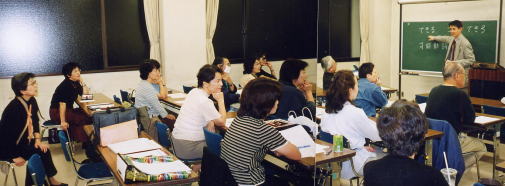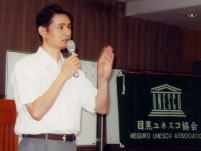No.191-4
|
|
Sponsored by Meguro City Board of Education
Coordinated and Organised by Meguro UNESCO Association
Date and Time: September 12, 2002, 18:30-20:00
Place: Midorigaoka Bunka Kaikan
Lecturer: Associate Professor Jyun Mikado, Asia University
Title: The Frontier of Japanese Education
|
Mr. Mikado, who has been teaching foreign students through Japanese Language Courses, gave an impressive lecture to people training to be volunteer Japanese teachers. (This lecture was given as an orientation to the Japanese Language Teaching Methods Course.)
The lecturer explained, through materials and video tapes, that a tremendous change can be seen in foreign students` reasons for coming to Japan, the situation of their home countries, and of their lifestyle here.
Mr. Mikado told the attendees that when they meet foreign students, sometimes the students will show a different face to that seen on campus; a face of their private lives. Recognising this is very important for getting along with them. He also advised them to keep abreast of the changing culture in students' countries and recent news items that help for better understanding of the students.
Some of the points from the lecture:
*Situation of the students:
Chinese: Years ago, students from China were elder sons who were selected from a family and supported by money from their relatives wishing them a successful future. Now, because of the ‘One Child Policy’, they have been brought up cherished, pampered and spoiled as though they were a small emperor. So, it is not difficult to meet young Chinese who went school by taxi and have never had experience cooking.
Korean and Taiwanese: Because of their countries' policy to increase the ratio of students who go to university or college, the governments have permitted many new private universities to be established. Students can now enter universities in their home countries, even if their ability is not very high. Now the question is; why do they come to Japan to study?
Malaysian: American universities have been recruiting top students from Malaysia and this has had a negative impact on Japanese universities.
European & American: As many of them are exchange students, they leave Japan after about 1 year. Their purpose for coming is not for the credit units.
*The Students’Image of Japan: What attracts them?
The image of Japan has shifted from ‘Hard’ goods (Toshiba, Hitachi, Toyota or Nissan) to ‘Soft’ products such as animation, manga (cartoons and comics) and computer games, and these things attract foreign students. After finishing education in Japan, some establish companies exporting Japanese animations and some become translators for cartoons.
*Money:
Recently, scholarships from the Japanese government have increased and when combined with those from schools or private organizations, it has become easier for some students to live in Tokyo. However, some students have a different attitude to money. This tendency comes from the social situation of some countries where money is associated with VIP status and money for them is the prime motive for being here. Some students drift from respectable part-time job to dubious jobs which make more money easily. This is a serious problem for universities because they have to keep an eye on them.
*Japanese Students:
I am concerned about the attitude of Japanese students towards foreign students. It seems to me that they tend to stay away from them. Japanese students sometimes quit a class when it has many foreign students
Reports: Mr. Yoshio Shimizu, Training Committee
Japanese Language Education Training Course (Short Program)
--- the lecture given by Associate Professor Mikado
|
 Jyun Mikado, Associate Professor of Asia University
Jyun Mikado, Associate Professor of Asia University
Place: Midorigaoka Bunka Kaikan
Dates: September 12 〜 (Tuesday and Thursday) 15 times.
Japanese Language Teaching Methods for Volunteer Teachers
Useful points for new teachers as well as how to break barriers and avoid pitfalls in the classroom, are shown in the course.)

